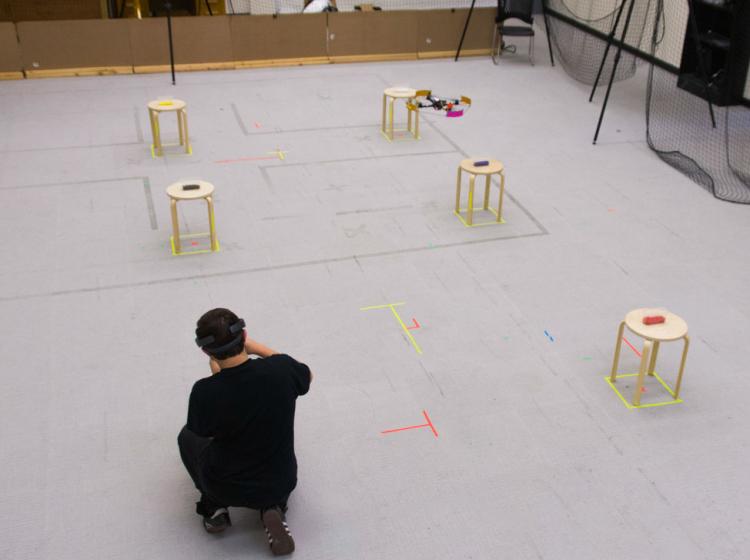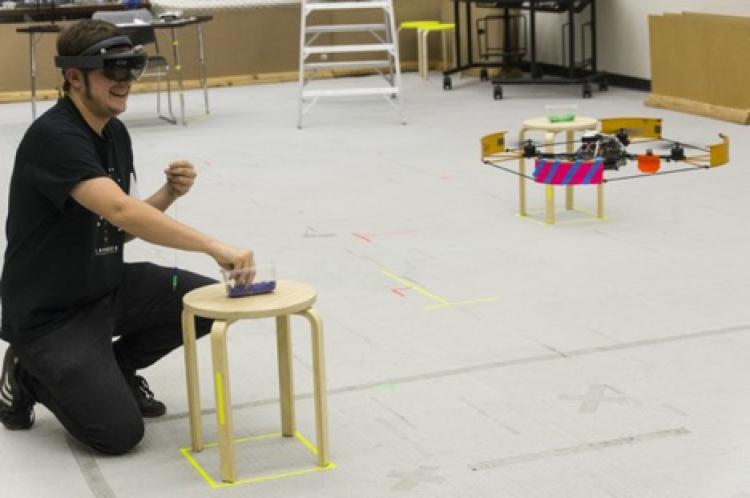Augmented reality enhances robot collaboration
Thousands of exciting and novel applications of augmented reality and robotic technologies have emerged in recent years, but the potential for networking these two technologies and using them in conjunction with each other has gone relatively unexplored. However, two papers published by the ATLAS Iron Lab last week for the ACM/IEEE International Conference on Human Robot Interaction in Chicago open the door to this promising area of research, paving the way for more seamless integration of robots in modern life.
Recognizing the value of their innovative work, conference organizers awarded the IRON Lab teams best paper and runner-up best paper in the design category. Assistant Professor Dan Szafir, who directs the IRON Lab, explains that both papers examine the potential for transmitting real-time visual information from drones to people with AR. In the first study, research participants completing an assembly task while sharing a workspace with a drone were more efficient when informed of the drone's flightpath using AR, versus tracking its path without assistance. In the second study, drone photography proved safer and more accurate when a drone camera’s field of view was streamed to operators' AR displays instead of tablet screens, as is the norm today.
To conduct the first study, researchers set up an environment

Results found that when the drone’s imminent flightpath was communicated with AR, participants were more efficient. Furthermore, the study evaluated tradeoffs in a variety of different graphical approaches to communicating the drone’s flightpath, which may help guide the design of future AR interfaces.
The second study found that AR technology helped drone operators take photos more safely and with more accuracy. Using a drone-mounted camera, research subjects were asked to photograph framed targets on a wall as quickly and precisely as possible. The drone camera’s field of view was visible to operators using a handheld tablet and using AR, in a variety of graphical configurations.
Results were judged by how fast subjects completed the task, the accuracy of their photos and the number of times the drones crashed. Once again, the study found AR significantly improved performance, increasing accuracy and reducing the number of crashes, with some AR graphical approaches proving more effective than others.

Taking place over a 12-month period, the two studies Szafir supervised were conducted by PhD students Michael Walker and Hooman Hedayati, along with master’s student Jennifer Lee. After being launched in January 2016 and Szafir making the Forbes "30 Under 30: Science" list in January 2017, the IRON Lab's latest commendations from the world's preeminent HRI conference sets expectations high for this ambitious and growing group of researchers.
Communicating Robot Motion Intent with Augmented Reality by Michael Walker, Hooman Hedayati, Jennifer Lee, and Daniel Szafir (Best Paper—Design, ACM/IEEE International Conference on Human Robot Interaction, 2018)
Improving Collocated Robot Teleoperation with Augmented Reality by Hooman Hedayati, Michael Walker and Daniel Szafir (Runner-Up Best Paper—Design, ACM/IEEE International Conference on Human Robot Interaction, 2018)


